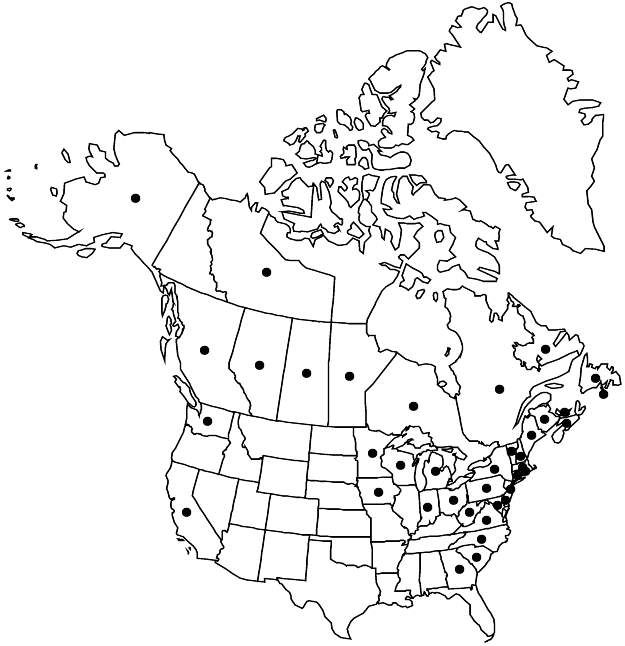Sarracenia purpurea subsp. purpurea
Rhizomes usually vertical, sometimes horizontal. Pitchers 6–10 per crown, length 3.5+ times diam., external surface glabrous or glabrate, setae on adaxial surface of hood 0.6–1.2 (–2.2) mm.
Phenology: Flowering Mar–Aug.
Habitat: Peat bogs, raised peatlands, alkaline fens, montane seepage bogs, swamps (dominants may include red maple, tamarack, black spruce, Atlantic white cedar), boreal conifer woodlands, boggy interdune swales, glacial lake and pond margins, moist to wet pitch pine
Elevation: 0-1000 m
Distribution

St. Pierre and Miquelon, Alta., B.C., Man., N.B., Nfld. and Labr., N.W.T., N.S., Ont., P.E.I., Que., Sask., Alaska, Calif., Conn., Del., Ga., Ind., Iowa, Maine, Md., Mass., Mich., Minn., N.H., N.J., N.Y., N.C., Ohio, Pa., R.I., S.C., Vt., Va., Wash., W.Va., Wis., in Europe (British Isles), in Europe (Switzerland), e Asia (Japan)
Discussion
Subspecies purpurea is introduced in California and Washington, in Europe in the British Isles and Switzerland, and in Japan. It is widespread and variable, and its adaptability is evidenced by the kinds of wetland habitats in which it grows. It is widely grown for ornament and teaching purposes and is the subject of much research on microorganisms and invertebrates, especially Wyeomyia Theobald mosquito larvae that live in the pitcher fluid.
Forma heterophylla (Eaton) Fernald is a mutant that seems to have lost the ability to form red anthocyanin pigments; the entire plant is a striking green to yellowish green. All other characteristics are as for subsp. purpurea. It seems to be a stable entity, maintaining itself in cultivation. Selfed plants or crossed yellow individuals yield anthocyanin-free progeny. It flowers in June to July and occurs in peat bogs and sandy-peaty swales throughout the northeastern range of subsp. purpurea, notably Massachusetts, Michigan, New Jersey, New York, Vermont, New Brunswick, Newfoundland, Nova Scotia, Ontario, and Quebec.
Variety montana D. E. Schnell & Determan has been described for plants found in the mountains of northern Georgia (Rabun County), northwestern South Carolina (Greenville and Pickens counties), and adjacent mountains and western piedmont of North Carolina (Alexander, Buncombe, Henderson, Iredell, Jackson, Macon, and Transylvania counties). We believe that the traits used to differentiate this variety—hoods with distal margins closely incurved, touching or nearly touching in the distal one-third to one-half, and setae lining the adaxial surface of the hood 0.9–1 mm—are not sufficiently exclusive to the plants of that region to allow consistent identification. These character states are commonly seen in plants throughout the more northern range of Sarracenia purpurea. We feel that subsp. purpurea simply extends southward into the mountains of the southern Blue Ridge. It is becoming exceedingly rare there in sphagnum bogs and seeps near waterfalls, where it sometimes grows with S. jonesii; both suffer from habitat loss due to development, drainage, and forest succession as this region becomes warmer and drier. Most of the plants in typical habitats in the mountains are robust like their northern counterparts; some of the specimens from the mountains of northern Georgia seem to be genetic dwarfs—they remain small even in common garden culture.
Selected References
None.
Lower Taxa
"winged" is not a number."variable" is not a number.No values specified.